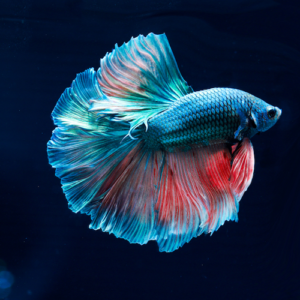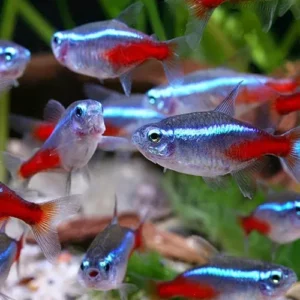Betta Fish Breeding Guide: The Most Important Steps
Betta fish breeding begins with setting up a suitable environment, ideally in a 10-gallon tank with optimal water parameters. During courtship, males display vibrant colors and build bubble nests, while females show readiness through subtle flaring and body postures. After a series of embraces, the female releases eggs, which the male fertilizes and then carefully places in his bubble nest. For the first few days, Betta fry feed on microscopic infusoria, transitioning to microworms and baby brine shrimp as they grow. Around 3-4 months post-hatching, the young Bettas are ready to transition to regular tank conditions.
Home » Guides » Fish Care » Betta Fish » Betta Fish Breeding Guide: The Most Important Steps
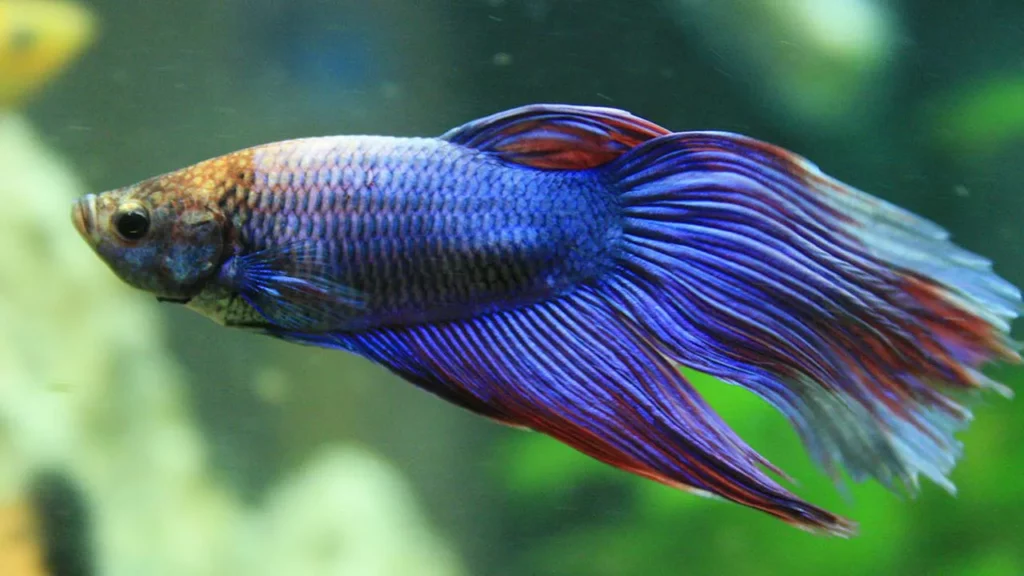
|
|
|
|
|
|
|
|
Betta Fish Fact Sheet
| Scientific Name | Betta Sp. Slendens |
| Common Name | Betta, Siamese Fighting Fish |
| Care Difficulty | Medium |
| Minimum Tank Size | 10+ Gallons (45+ Liters) |
| Life Expectancy | 5 Years |
| Average Size | 3 Inch (6cm) |
| Temperature | 76-82°F (24-28°C) |
| Diet | Omnivore |
| Behavior | Territorial |
| Breeding | Medium |
| pH | 6.5-7.5 |
| dGH | 0-10 (0-179PPM) |
| Live Plant Friendly | Yes |
Aquarium Setup for Breeding Bettas
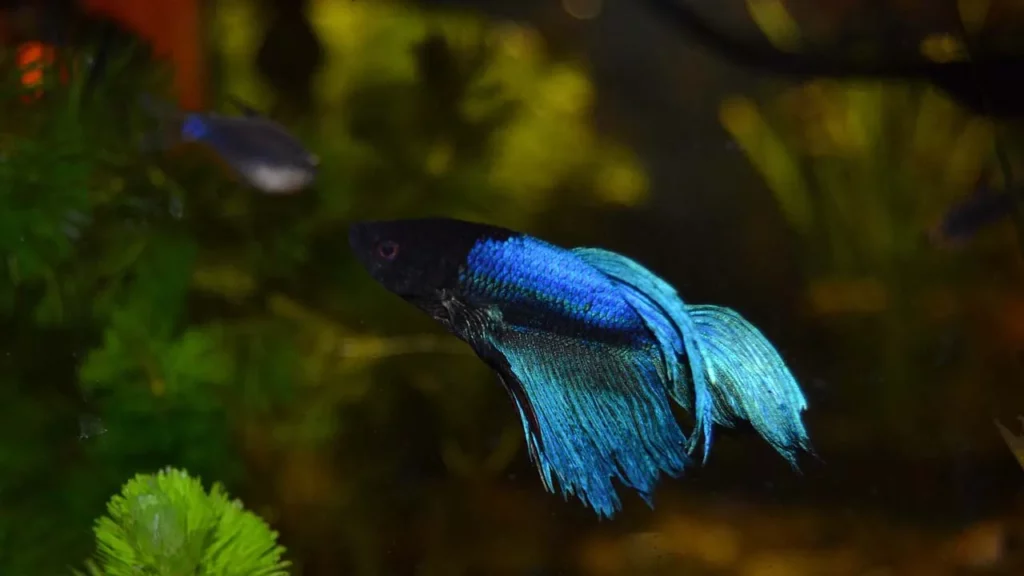
Ideal tank size for breeding pairs
For breeding pairs, a tank size of 10 to 20 gallons is generally recommended. This provides enough room for the Betta fish to swim freely, engage in their courtship dances, and establish territories. A larger space reduces stress on the fish, which is crucial for successful breeding. Stress can inhibit spawning behaviors and even lead to aggression between the pair.
Now, while it might be tempting to opt for a smaller tank, thinking it might be easier to manage, remember that a smaller environment can lead to rapid changes in water parameters. This can be detrimental to the health of the fish and the success of the breeding process. A larger tank offers more stability in terms of water conditions, which is essential for the delicate process of Betta fish reproduction.
Water parameters
Water, the elixir of life! Just as we humans thrive in a comfortable environment, Betta fish have specific water conditions that they prefer, especially when it comes to breeding. Ensuring the right water parameters is akin to setting the mood lighting for a romantic evening.
Temperature: Betta fish are tropical creatures, hailing from the warm waters of Thailand and Cambodia. For breeding, the water temperature should be maintained between 78°F to 82°F (25°C to 28°C). This warm environment encourages spawning behavior and ensures the well-being of the eggs and fry. A reliable aquarium heater and a good thermometer are essential tools to maintain and monitor this range.
pH Level: The pH level indicates how acidic or alkaline the water is. Betta fish prefer slightly acidic to neutral water for breeding, with a pH range of 6.5 to 7.5. Consistency is key here. Sudden changes in pH can stress the fish and hinder the breeding process.
Hardness: The general hardness (GH) and carbonate hardness (KH) of the water can influence the health of Betta fish. Soft to moderately hard water is ideal, with a GH between 3 to 12 dGH and a KH of 3 to 8 dKH.
Ammonia, Nitrite, and Nitrate: These are the three musketeers of water chemistry that every aquarist should be wary of. Ammonia and nitrite levels should always be at zero, as even trace amounts can be harmful. Nitrate levels should be kept low, preferably below 20 ppm. Regular water testing and changes are crucial to maintain these parameters.
TDS (Total Dissolved Solids): While not always discussed, TDS can play a role in Betta breeding. A TDS reading between 50 to 200 ppm is generally considered suitable.
Filtration and aeration considerations
Filtration: While Betta fish are known for their resilience and ability to thrive in still waters, a filter is essential for breeding tanks. It helps in maintaining water clarity, removing waste, and ensuring a stable environment. However, there’s a catch. Bettas aren’t fans of strong currents, and their delicate fins can be easily damaged by powerful filter outflows. So, what’s the solution?
Opt for a sponge filter. These filters are gentle, yet effective. They create minimal water disturbance, making them perfect for breeding tanks. Sponge filters also provide an added benefit: they serve as a grazing ground for fry, offering tiny microorganisms for them to feed on.
Aeration: While Betta fish have a unique labyrinth organ that allows them to breathe atmospheric air, aeration is still beneficial, especially in a breeding setup. A gentle flow of bubbles can help distribute heat evenly throughout the tank and ensure that the water is adequately oxygenated for the eggs and fry.
However, just like with filtration, the key is gentleness. A strong airstone or air pump can disrupt the male Betta’s bubble nest, which is a crucial part of the breeding process. Opt for adjustable air pumps or use a valve to control the airflow, ensuring a gentle stream of bubbles that won’t wreak havoc on the nest.
Substrate and decorations
Plants Beneficial for Breeding
Nature’s own decor, and so much more than just a green touch. In the realm of Betta breeding, plants play a multifaceted role, offering shelter, security, and even aiding in the breeding process itself.
Floating Plants: These are the crown jewels for Betta breeding. Floating plants like Salvinia, Duckweed, and Frogbit provide a sense of security for Betta fish. The dangling roots offer hiding spots, and the surface coverage can encourage male Bettas to build their bubble nests beneath them. Plus, they help in diffusing harsh lighting, creating a serene environment.
Broad-leaved Plants: Think of plants like Anubias or Amazon Sword. Their broad leaves serve as potential sites for bubble nest building. They also offer a refuge for the female Betta, allowing her to hide and rest after spawning. The leaves can sometimes even act as a canvas for the male Betta’s courtship dance, as he tries to woo his partner.
Stem Plants: Plants like Cabomba and Hornwort are not just aesthetically pleasing but are also functional. Their dense growth offers hiding spots for the female and the fry. Moreover, their fine leaves and stems can trap microorganisms, providing a natural buffet for the fry in their early days.
Mosses: Java Moss and Christmas Moss are excellent additions to a breeding tank. They offer intricate hiding spots and, just like stem plants, can harbor tiny edible organisms for the fry.
Bubble Nest Facilitation
The bubble nest – a testament to a male Betta’s dedication and a cradle for the next generation. These delicate structures are fascinating, and facilitating their creation is a blend of art and science.
Leaf Ledges and Floating Objects: Male Bettas often prefer to build their bubble nests under a sheltered area. Providing them with artificial or natural leaf ledges near the water surface can be an invitation for nest building. Similarly, floating objects like a small piece of Styrofoam or an almond leaf can serve as an anchor for these nests. The underside of these objects provides a sense of security and a clear boundary for the male to work within.
Indian Almond Leaves: A favorite among Betta breeders, Indian Almond Leaves (IAL) release tannins into the water, which not only provide beneficial antibacterial properties but also tint the water with a tea-like color, mimicking the natural habitats of Betta fish. When floated, the broad surface of the IAL becomes an ideal site for bubble nest construction.
Reduced Water Flow: As we touched upon earlier, a strong current can be the nemesis of a bubble nest. Ensuring that the water flow in the tank is gentle will help the male Betta maintain his meticulously crafted nest. Sponge filters, with their gentle outflow, are again a great choice in this regard.
Encouraging Conditions: While Bettas can and will build bubble nests even without the presence of a female, introducing a female (while ensuring she has places to hide and retreat) can stimulate the male’s nesting behavior. Observing the female and being in her presence often encourages the male to create a more robust and larger nest.
Diet and Nutrition
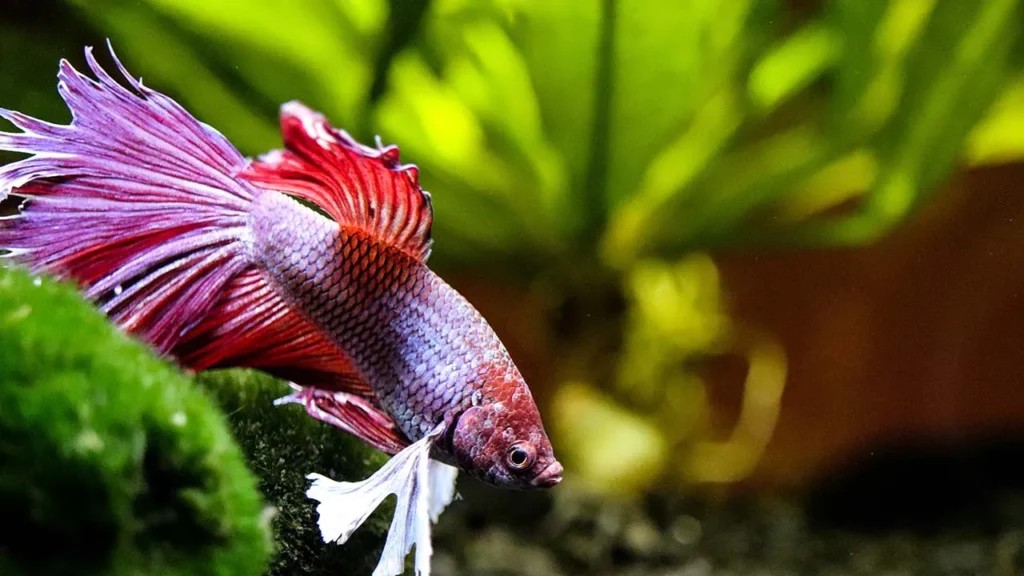
Role of diet in breeding readiness
When it comes to breeding, nutrition plays a pivotal role in ensuring both the male and female are in peak condition. A well-balanced diet boosts their energy, enhances their colors, and most importantly, ensures the production of healthy eggs and robust milt (sperm) for successful fertilization.
Nutritional Boost: Breeding is an energy-intensive process. The courtship dances, the act of spawning, guarding the nest, and looking after the fry – all these activities demand extra energy. A diet rich in proteins and essential fats ensures that the Betta fish have the necessary stamina and vitality for these tasks.
Egg Production: For the female Betta, a protein-rich diet is crucial in the weeks leading up to breeding. Proteins are the building blocks of eggs. A diet deficient in proteins can lead to fewer eggs, and those that are produced might be of lower quality.
Enhanced Coloration: A vibrant and colorful Betta is often a sign of good health and breeding readiness. Many high-quality fish foods contain natural color enhancers, which can make the Betta’s colors pop, signaling their prime condition for breeding.
Immune System Boost: Breeding can be stressful, and stress can lower the immune response. A diet rich in essential vitamins and minerals can bolster the Betta’s immune system, ensuring they remain healthy throughout the breeding process.
Types of food
The culinary world of Betta fish is vast and varied. Just as we relish a diverse diet, our finned friends too thrive on a mix of nutrients from different sources.
Live Foods: These are the crème de la crème for Betta fish, especially when conditioning them for breeding. Brine shrimp, daphnia, and bloodworms are among the top choices. Live foods mimic the Betta’s natural diet and provide essential proteins and fats. They also stimulate the Betta’s hunting instincts, keeping them active and engaged.
Frozen Foods: A close second to live foods, frozen options like frozen brine shrimp, bloodworms, and mosquito larvae offer a balanced diet without the risk of introducing parasites or diseases, which can sometimes be a concern with live foods.
Pellets and Flakes: These are the staple for many Betta keepers. When choosing pellets or flakes, always opt for those specifically formulated for Betta fish. They are protein-rich and often contain essential vitamins and minerals. However, ensure the pellets are of appropriate size for the Betta’s mouth, and remember, quality matters. High-quality pellets will have fish or aquatic animals as their primary ingredients.
Vegetable Matter: While Betta fish are primarily carnivorous, they can occasionally benefit from small amounts of vegetable matter. Foods like blanched peas can act as a dietary supplement, aiding in digestion and providing essential fibers.
Homemade Foods: For those who like to add a personal touch, there are recipes available for homemade Betta food. These often combine various protein sources, like fish and shrimp, with added vitamins and gelatin to bind everything together.
Supplements: Just as we sometimes need a vitamin boost, Betta fish can benefit from supplements, especially during the breeding phase. Products that enhance color, boost the immune system, or provide essential fatty acids can be sprinkled or mixed into their regular food.
Feeding routines for breeding Betta fish
Frequency: When conditioning Betta fish for breeding, it’s advisable to feed them smaller amounts but more frequently. Instead of a single large meal, offer them 2-3 smaller meals throughout the day. This ensures a steady supply of energy, vital for the demanding breeding process.
Quantity: Overfeeding can be as detrimental as underfeeding. Offer only what they can consume in about 2-3 minutes. Any uneaten food should be removed promptly to maintain water quality. Remember, a bloated Betta is not a happy or healthy Betta.
Live Food Treats: Introduce live foods into their diet more frequently during the conditioning phase. These protein-rich treats not only boost their energy but also stimulate their natural hunting instincts, keeping them active and alert.
Observation: Pay close attention to how your Betta reacts to the food. If they seem disinterested in a particular type, switch it up. Observing their eating habits can also give insights into their overall health and readiness for breeding.
Cleanliness: Just as we prefer dining in a clean environment, so do our aquatic friends. Ensure that the tank is clean, and the water parameters are stable. A dirty environment can lead to reduced appetite and increased stress.
Post-Spawning Care: After the spawning process, the female might need some time to recuperate. Offer her high-quality, protein-rich foods to help her regain her strength. The male, busy guarding the nest, might eat less during this period. But ensure he has access to food, even if in smaller quantities.
Selecting Breeding Pairs
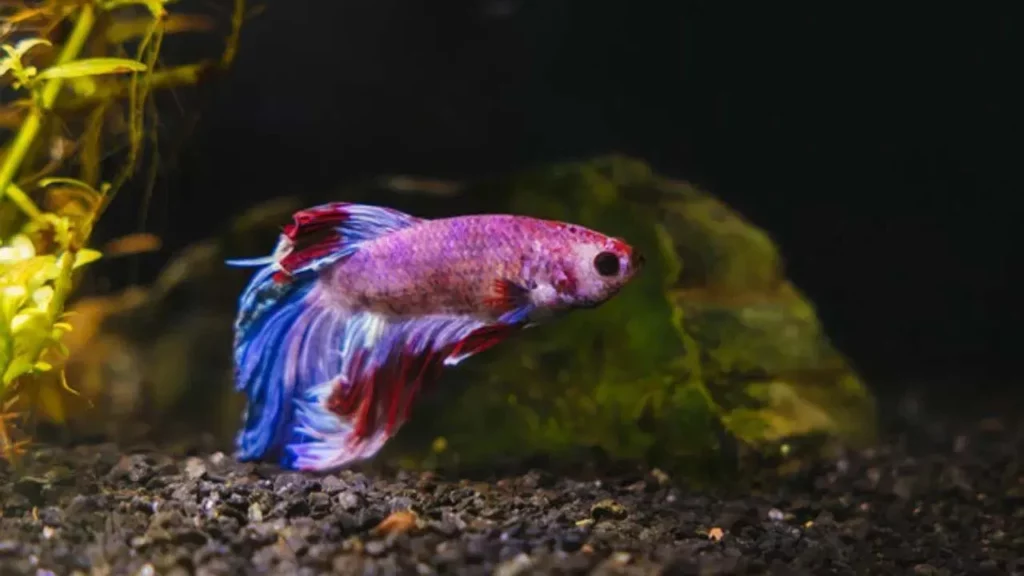
Age and maturity considerations
Prime Age for Breeding: Betta fish typically reach sexual maturity between 4 to 6 months of age. This is the prime window for breeding, as both males and females are at their peak fertility. Their vibrant colors, energy levels, and reproductive capabilities are most potent during this period.
The Youthful Zeal: Younger Betta fish, while enthusiastic, might lack the experience. It’s not uncommon for first-time breeders to be a bit clumsy during the courtship rituals or the spawning process. However, their vigor and resilience often make up for their lack of finesse.
The Wisdom of Age: Older Betta fish, around 12 to 14 months or more, might have the experience but could lack the same vitality as their younger counterparts. While they can still breed, the number of eggs produced might be fewer, and the overall success rate could be lower.
The Sweet Spot: Many breeders believe that the ideal age for breeding Betta fish is between 6 to 9 months. During this period, they strike a balance between youthful energy and some level of experience, leading to higher chances of successful breeding.
Age-Related Challenges: As Betta fish age, there can be challenges. Older females might produce fewer eggs, and the viability of these eggs might be reduced. Older males, on the other hand, might not be as diligent in guarding the nest or caring for the fry.
Identifying healthy Betta fish
Vibrant Colors: One of the most evident signs of a healthy Betta is its coloration. A Betta in prime health will display bright, vivid colors without any signs of fading or discoloration. Dull or patchy colors can indicate stress, illness, or poor nutrition.
Active Behavior: A healthy Betta is an active Betta. They should be curious, responsive to their environment, and show interest in their surroundings. Lethargy or prolonged periods of hiding can be red flags.
Clear Eyes: The eyes are often said to be the windows to the soul, and in the case of Betta fish, they’re windows to their health. Their eyes should be clear, bright, and free from cloudiness or swelling.
Smooth Scales: The scales of a healthy Betta should lie flat against their body, creating a smooth silhouette. Raised or pineconing scales can be indicative of serious health issues like dropsy.
Full, But Not Bloated, Belly: While a well-fed Betta will have a slightly rounded belly, excessive swelling or bloating can be a sign of overfeeding, constipation, or other health concerns.
Fins in Prime Condition: The majestic fins of a Betta are a sight to behold. They should be spread out, free from tears, clamping, or fraying. Any signs of fin rot, white spots, or ragged edges can indicate health problems.
Absence of Parasites or Diseases: Ensure your Betta is free from visible parasites, white spots (indicative of ich), or any cottony growths. A quarantine period for new fish can help prevent the introduction of diseases into your breeding setup.
Breathing Patterns: While Betta fish do breathe atmospheric air, rapid gill movement or frequent surfacing for air can be signs of distress or poor water quality.
Compatibility and pairing
Initial Observation: Before introducing the potential pair, it’s wise to let them see each other without direct contact. This can be achieved by placing their tanks side by side or using a clear divider in a shared tank. Watch their reactions. Flaring, while often seen as aggressive, is a natural courtship behavior. However, if either fish shows signs of extreme stress or fear, they might not be the best match.
Size Matters: While size isn’t everything, it does play a role in Betta pairing. Ideally, the female should be slightly smaller or of similar size to the male. A significantly larger female might intimidate or even injure the male during the courtship process.
Age Compatibility: As discussed earlier, age plays a role in Betta breeding. While it’s not a strict rule, pairing Bettas of similar age can increase the chances of successful spawning. They’re more likely to be in sync in terms of energy levels and reproductive readiness.
Temperament Check: Just like humans, Bettas have personalities. Some are mellow, while others are feisty. Observing the temperament of each fish can give insights into their compatibility. Two overly aggressive Bettas might not be the best match, while a very timid Betta paired with an aggressive one might lead to undue stress.
Trial and Error: Sometimes, despite all observations and precautions, a pair might not click. If repeated attempts at introduction lead to aggressive behavior without any signs of courtship, it might be best to consider different partners for both fish.
Safety First: Always ensure that the female has plenty of hiding spots and escape routes in the breeding tank. This allows her to retreat and recover if the courtship becomes too intense or aggressive.
Breeding Process
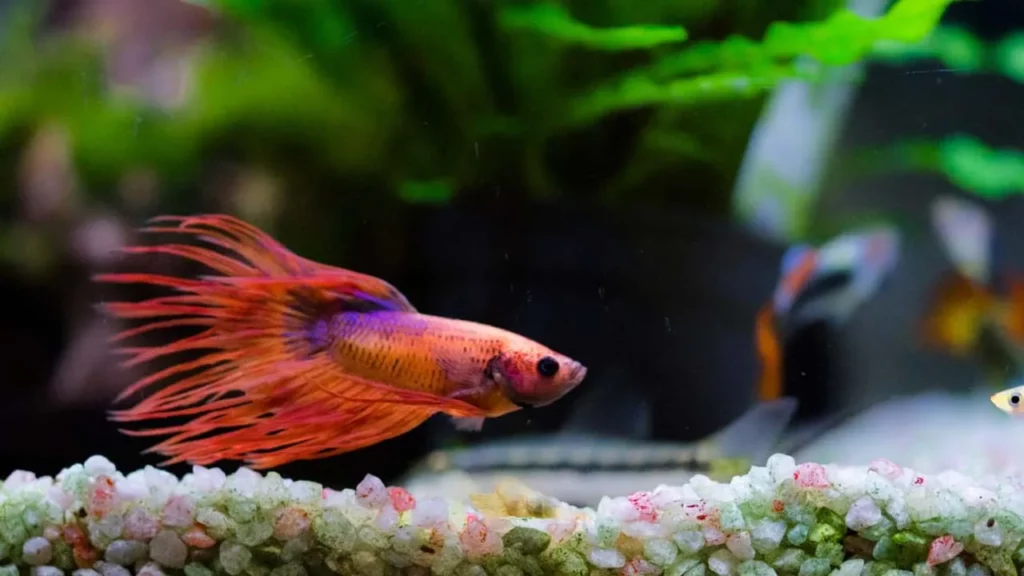
Courtship rituals and behaviors
Flaring and Display: The male Betta, in his quest to impress the female, will often flare his gills and spread his fins to their fullest. This display showcases his health, vigor, and genetic prowess. The female, if interested, might respond with subtle flaring and display her own set of vibrant colors.
Dancing Moves: The male often engages in a zig-zag dance, darting back and forth in front of the female. This dance is both an invitation and a challenge, urging the female to join him in the spawning process.
Chasing: It’s a game of pursuit! The male might chase the female around the tank. While this might seem aggressive, it’s a natural part of their courtship. However, it’s essential to ensure that the female has places to hide and rest, as continuous chasing without breaks can stress her out.
Nest Showing: Once the male has built his bubble nest, he will frequently guide the female towards it. It’s his way of saying, “Look at the home I’ve built for our offspring!” The quality and size of the nest can influence the female’s decision to spawn with the male.
Gentle Nips and Touches: As the courtship progresses, the male might give gentle nips to the female’s body, especially around her belly area. These nips are not aggressive but are rather signals indicating his readiness to spawn.
Submissive Posture: If the female is receptive to the male’s advances, she might display a submissive posture. This involves curving her body slightly and showing her underbelly, signaling her willingness to release eggs.
Bubble nest building
The bubble nest – a marvel of nature, meticulously crafted with care and precision. It’s the male Betta’s labor of love, a testament to his dedication and a sanctuary for the next generation.
Why Bubble Nests? In the wild, waters can often be stagnant with low oxygen levels. The bubble nest provides a safe, oxygen-rich environment for the eggs and the newly hatched fry. Each bubble, created by the male, contains a tiny pocket of air, ensuring that the developing embryos have a steady oxygen supply.
The Building Process: Using his mouth, the male Betta takes a gulp of air from the surface. He then releases this air wrapped in a layer of saliva, forming a bubble. This process is repeated hundreds of times, creating a dense mat of bubbles, often anchored to plants, debris, or even the tank’s side.
Location, Location, Location: The male is quite picky about where he builds his nest. He often chooses a sheltered spot, beneath leaves or floating objects, to protect the nest from disturbances and potential predators.
Size and Structure: The size of the bubble nest can vary. Some nests are sprawling, covering a large surface area, while others are more compact. The size often depends on the male’s age, health, and experience. A larger, denser nest is usually a sign of a healthy and confident male.
Maintenance: The male Betta is a diligent caretaker. He constantly repairs and maintains the nest, adding new bubbles and ensuring its integrity. Once the eggs are laid, he meticulously places them within the bubbles, guarding them with unwavering dedication.
A Sign of Readiness: While male Bettas can and often do build bubble nests without the presence of a female, the act of nest-building intensifies when a potential mate is nearby. It’s his way of signaling his readiness to spawn and his commitment to protecting the offspring.
The bubble nest is more than just a cluster of bubbles. It’s a cradle, a fortress, and a symbol of hope for the future. As you watch a male Betta craft each bubble with precision, remember, you’re witnessing a ritual as old as time, a delicate dance of nature where love, dedication, and hope float together, creating a promise of new life.
Spawning and egg-laying
The Embrace: As the female signals her readiness, the male will approach her, wrapping his body around hers in a gentle, U-shaped embrace. This act, often referred to as the “nuptial embrace,” is both tender and purposeful. It ensures that the male is positioned perfectly to fertilize the eggs as the female releases them.
Egg Release: During the embrace, the female releases a batch of eggs, which float upwards. The number of eggs can vary, ranging from a few dozen to several hundred, depending on the age and health of the female.
Fertilization: As the eggs are released, the male releases his milt, ensuring the eggs are fertilized. This external method of fertilization is common among many fish species.
Collecting the Eggs: Post-spawning, the female might be momentarily stunned, often floating in a daze. The male, showcasing his dedication, quickly gets to work, collecting the eggs in his mouth and placing them meticulously within the bubbles of his nest. Some females might assist in gathering the eggs, but it’s primarily the male’s responsibility.
Multiple Embraces: The spawning process isn’t a one-time event. The pair might engage in multiple embraces, with short breaks in between, until the female has released all her eggs. This can span several hours, showcasing the stamina and dedication of both fish.
Post-Spawning Behavior: Once all the eggs are laid and safely tucked within the bubble nest, the male’s protective instincts kick into high gear. He becomes the guardian of the nest, diligently watching over the eggs and ensuring their safety. The female, having played her part, is often chased away by the male, as her presence might pose a threat to the eggs. It’s advisable to remove the female from the breeding tank at this stage to ensure her safety and the safety of the future fry.
Role of the male in egg care
Guardian of the Nest: The male Betta is the sole protector of the bubble nest. With unwavering dedication, he patrols the vicinity, warding off potential threats and ensuring the safety of the eggs nestled within the bubbles.
Bubble Repairman: Over time, bubbles can burst or merge, compromising the nest’s structure. The male diligently repairs and maintains the nest, adding new bubbles as needed and ensuring its integrity.
Egg Collector: Despite the buoyancy of the bubbles, some eggs might fall out of the nest. With gentle care, the male collects any stray eggs in his mouth and places them back into the safety of the bubbles. This behavior showcases his commitment to ensuring every potential offspring has a chance at life.
Temperature Regulator: The male often uses his fins to fan the eggs. This gentle fanning not only provides oxygen but also helps regulate the temperature around the eggs, ensuring optimal conditions for their development.
First Line of Defense: If any intruders approach the nest, be it other fish or even inquisitive snails, the male is quick to chase them away. His protective instincts are on high alert, and he’s ready to defend his future offspring at all costs.
Transition to Fry Care: Once the eggs hatch, the male’s role shifts from egg protector to fry guardian. While the newly hatched fry can initially cling to the nest’s bubbles, they soon become free-swimming. The male continues to watch over them, often herding stray fry back to the safety of the nest.
However, as the fry grow and become more independent, the male’s protective instincts might wane, and there’s a risk he might see them as food. At this stage, it’s advisable to remove the male from the tank to ensure the safety of the fry.
Rearing the Betta Fry
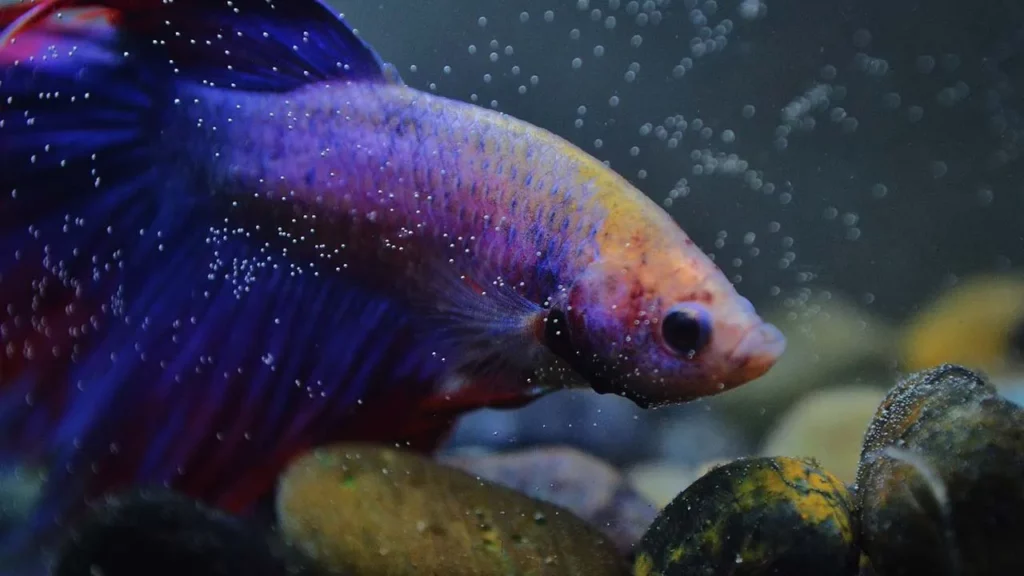
Initial care post-hatching
Suitable First Foods
Infusoria: These are microscopic organisms that thrive in aquatic environments. For the first few days of their lives, Betta fry can feed on naturally occurring infusoria in the tank. To ensure a steady supply, many breeders prepare an infusoria culture a week or so before the expected hatching. This culture can be made using lettuce leaves or other organic materials in a jar of water, left to ferment until the water is cloudy with these tiny organisms.
Microworms: As the fry grow a bit larger, usually after the first week, they can start feeding on microworms. These tiny worms are easy to culture at home using oatmeal or bread as a base. They provide essential proteins that support rapid growth in the fry.
Baby Brine Shrimp (BBS): A few days post-hatching, once the fry are big enough to handle them, baby brine shrimp become an excellent food source. Rich in proteins and fats, BBS are like the gourmet dish for Betta fry. They not only provide essential nutrients but also stimulate the fry’s hunting instincts, as the shrimp dart around in the water.
Vinegar Eels: Another suitable first food, vinegar eels are tiny nematodes that can be cultured in apple cider vinegar. They’re a good alternative or supplement to microworms and BBS.
Commercial Fry Foods: There are several high-quality commercial foods available, specifically formulated for fish fry. These often come in powder form, ensuring the particles are small enough for the fry to consume. While they’re convenient, it’s always a good idea to supplement commercial foods with live or freshly hatched options to ensure a varied diet.
Remember, just like human babies, Betta fry have tiny stomachs but big appetites. Frequent, small feedings are the key. Overfeeding can lead to water quality issues, so it’s essential to monitor the tank and remove any uneaten food promptly.
Water Changes and Safety
Frequency of Changes: While it’s essential to maintain clean water, frequent and large water changes can be stressful for the fry. Instead, opt for smaller, more regular changes. Removing 10-15% of the tank water daily and replacing it with fresh, dechlorinated water can help maintain water quality without causing undue stress.
Gentle Water Movement: When siphoning out water, it’s crucial to be gentle. Using air tubing instead of a regular siphon can help ensure the fry aren’t accidentally sucked out. Similarly, when adding fresh water, pour it in slowly, preferably using a drip method, to avoid sudden changes in water parameters and to prevent disturbing the fry.
Temperature Consistency: Betta fry are sensitive to temperature fluctuations. Ensure that the fresh water added is of the same temperature as the tank water. This consistency helps in preventing thermal shock, which can be detrimental to the fry.
Water Quality Monitoring: Regularly test the water for ammonia, nitrites, and nitrates. The metabolism of the fry is high, and they produce waste more frequently. Keeping a check on these parameters ensures that the water remains non-toxic for the fry.
Avoid Overfeeding: As discussed earlier, Betta fry have voracious appetites. However, overfeeding can lead to uneaten food, which decomposes and deteriorates water quality. Feed them small amounts multiple times a day and remove any uneaten food promptly.
Beneficial Bacteria: Consider adding beneficial bacteria to the tank. These bacteria help in breaking down ammonia and nitrites, ensuring a healthier environment for the fry. Commercially available beneficial bacteria preparations can be a valuable addition to the fry tank.
Plants and Filtration: Live plants can act as natural filters, absorbing excess nutrients and providing hiding spots for the fry. If using a filter, ensure it’s fry-safe. Sponge filters are an excellent choice as they provide gentle water movement and reduce the risk of fry being sucked into the filter.
Growth stages and development
Hatching Stage: A few days post-spawning, the eggs hatch. These newly hatched fry are called ‘prolarvae.’ At this stage, they’re tiny, translucent, and not very mobile. They primarily rely on their yolk sacs for nourishment and often cling to the bubble nest or float near the water’s surface.
Free-Swimming Stage: After consuming their yolk sacs, usually within 2-3 days post-hatching, the fry become free-swimming. This is a significant milestone, marking their transition from passive existence to active exploration. They start venturing around the tank, and it’s also the time when they begin feeding on external food sources.
Juvenile Stage: Around two weeks post-hatching, the fry enter the juvenile stage. They start resembling miniature versions of adult Bettas, albeit without the vibrant colors and long fins. Their dietary needs become more diverse, and they can consume larger food particles. This stage is crucial for their overall development, and providing a varied, protein-rich diet ensures robust growth.
Sub-Adult Stage: By the time they’re a month old, the Betta fry transition to the sub-adult stage. Their colors start becoming more pronounced, and the differences between males and females begin to emerge. The males might start displaying territorial behaviors, and their fins begin to grow longer.
Adulthood: Around 3-4 months post-hatching, the Bettas are considered young adults. Their colors are vibrant, fins fully developed, and they exhibit all the characteristic behaviors of adult Bettas. By this stage, they’re ready to be moved to individual tanks, especially the males, to prevent territorial disputes.
Maturity and Breeding: By 4-6 months, the Bettas reach sexual maturity and are ready to start their own breeding journey, completing the circle of life.
Throughout these stages, it’s essential to monitor water quality, ensure a balanced diet, and provide ample space for the growing fry. Regular water changes, appropriate tank mates, and a stress-free environment contribute to their healthy development.
Transitioning fry to regular tank conditions
Gradual Acclimatization: Before moving the fry to a regular tank, it’s essential to acclimatize them gradually. Start by introducing water from the new tank into their current environment over several days. This helps them get used to the new water parameters and reduces the risk of shock.
Tank Setup: The new tank should be well-cycled, ensuring stable water parameters. Live plants can be a great addition, offering hiding spots and helping maintain water quality. Ensure the tank has a gentle filtration system, like a sponge filter, to prevent strong currents that might stress the young Bettas.
Dietary Transition: As the fry grow, their dietary needs evolve. While they might still relish the foods they’ve been accustomed to, introduce them to the diet you plan to offer in the regular tank. This can include high-quality Betta pellets, flakes, and occasional treats like live or frozen foods.
Monitoring Aggression: As the Betta fry mature, especially the males, they might exhibit territorial behaviors. Keep a close eye on them during the transition. If you notice aggressive behavior or signs of stress, consider providing dividers or moving aggressive individuals to separate spaces.
Temperature and Lighting: Ensure the new tank’s temperature is consistent with the fry’s current environment. A sudden change can be stressful. Similarly, maintain a consistent light cycle, mimicking their natural day-night rhythm.
Health Check: Before transitioning, it’s a good practice to check the fry for any signs of illness or parasites. Healthy fish will adapt better to new environments. If you notice any health concerns, address them before making the move.
Patience is Key: The transition is a significant change for the fry. It’s essential to be patient and allow them to explore and adapt at their own pace. Avoid making too many changes to the new tank initially, letting them settle in comfortably.
Frequently Asked Questions – FAQ
Give Us Feedback
Please help us get better by making suggestions or giving feedback, we really do listen to it!
